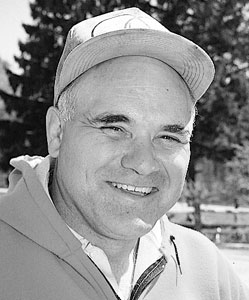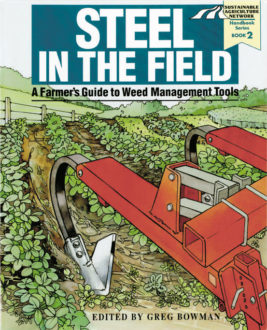
Agronomic Row Crops: The Farmers
Covers and Cultivation Check No-Till Weeds
Rich Bennett
Napoleon, Ohio
- 600 acres
- no-till rowed beans
- corn, soybeans, spring wheat
- minimum-till corn in 30-inch rows
- cover crops: cereal rye, hairy vetch
Weed management highlights
Strategies: Crop rotation... cover crops... herbicide kill or incorporation of covers... timely cultivation
Tools: High-residue cultivator... disk harrow
Rich Bennett has mastered an alternative low-input system that features planting soybeans into herbicide-killed grain rye or hairy vetch, cultivating crops twice, and cutting input costs for his 250 acres each of corn and soybeans.
His alternative practices help him avoid primary dependence on herbicides to combat the weed species shift to foxtail and panicum that become more challenging after several years into no-till. He pays close attention to timing tool use and quickly makes tool adjustments to accommodate changes in crop size and weed conditions.
Bennett began reducing fall tillage and using cover crops in 1989 to control wind erosion and minimize soil disturbance. A two-year on-farm research grant helped him hone the use of fall-planted grain rye to control weeds in soybeans. (The funds came from the USDA's Sustainable Agriculture Research and Education program.) He figures he saves at least $15 per acre compared with standard no-till soybean systems.
Besides providing a moisture-conserving mulch and weed-shading canopy, rye residue kept on the surface holds down weeds through allelopathy - a natural suppressive effect on one plant by compounds produced by another. This natural weed control allows him to skip rotary hoeing and postemergent herbicide in soybean fields. But rye can hurt bean yields if it mats heavily or takes up too much soil moisture in a dry spring.
Bennett plants rye in late October so that it emerges but shows little growth before winter dormancy. He broadcasts rye at 2 bushels per acre after disking cornstalks just once. 'I got away from choosing corn having bamboo-type stalks that needed two diskings to break down,' says Bennett.
He plants soybeans on 30-inch rows into the standing rye as soon as conditions allow in May, at 70 pounds per acre to ensure an adequate stand. His White no-till planter provides uniform placement and depth for soybean seeds and works well with different seed sizes. 'I leave the no-till coulters off and just use the disk opener. The coulters would stir up soil and stimulate foxtail and other weeds,' he notes.
Bennett reduces the amount of rye he knocks down with field-equipment by spraying it on the same pass that he plants beans. The tender rye is about 2.5 feet tall and providing plenty of shade. Roundup - applied at only 1.5 pints per acre - kills the rye, while 1 quart of Lasso controls nightshade. Adding 1.7 pounds of ammonium sulfate and 13 ounces of surfactant per acre increases herbicide absorption, giving Bennett good control with half the label rate for Roundup.
If you're not using herbicide burndowns, be sure to chop the rye by late boot stage and before it heads, cautions Illinois organic farmer Jack Erisman. He often overwinters cattle in rye fields that precede soybeans. But he prefers to wait until the soil temperature is at least 60 degrees before planting beans. That's too late for no-tilling soybeans into standing rye. 'If rye retillers and gets away from you, you'd be better off baling it or harvesting it for seed,' Erisman notes.
When his beans are 8 to 10 inches tall, Bennett sets the front edges of the disk hillers on his Buffalo Model 6300 maximum-residue cultivator about 3.5 inches on either side of the row. The disks peel back grasses and other weeds. He cultivates at about 4.5 to 5 mph, with the single sweep nearly flat, running 2.5 to 3 inches deep.
'I put just enough pitch on the one-piece sweep so it throws dirt nicely into the row. Even in cold, wet springs, rye puts on good growth and gives plenty of mulch. The rolling cultivator I used to use couldn't make it through all the biomass,' he says.
Bennett clears up the row middles two weeks later with a second cultivation. For this, he removes the metal, open-top panel shields necessary for protecting small crops. He also takes off the disk hillers or reverses positions and moves them away from the row to avoid throwing too much soil into the bean row. Other settings and speed are the same as for first cultivation. With a typical harvest of 45 bushels of soybeans per acre - 5 to 10 more than county average - Bennett is pleased with how well his rye/soybean system works.
Right after harvesting hairy vetch about the first week of August, Bennett thoroughly disk harrows the stubble in his recently combined wheat fields. He used to broadcast 25 to 30 pounds of hairy vetch seed per acre using two staggered, overlapping passes with a 40-foot-wide spreader.
In '96 he drilled hairy vetch seed to improve seed-to-soil contact and to eliminate his usual post-broadcast tillage with a disk and a rolling cultipacker. 'I must have been getting the seed tilled in too deeply. In '95 demo plots, 23 pounds drilled seed gave a better stand than broadcasting 30 pounds per acre,' observes Bennett. Using his conventional drill won't eliminate any preplant disking, though, as he has never gotten a good vetch stand unless he incorporates the wheat stubble.
With the help of Ben Stinner, an Ohio State University researcher who directs many farmer-oriented efforts in sustainable farming, Bennett is working to increase the efficiency and fertility value of hairy vetch in his no-till corn. Using vetch can lower fertilizer and herbicide bills but also can help give some weeds a faster growth rate. Here again, Bennett's single-sweep, no-till cultivator keeps row-middle weeds in check.
He had used 2,4-D to kill his vetch cover crop, but he's turned to disking to get a quicker release of nitrogen and to ensure an adequate seedbed for corn. He disks knee-high vetch in late April or early May. After the first pass with his tandem, smooth-bladed disk, he checks the field in several spots to flake back the top 2 inches of soils. 'If I see a lot of viney material in there, I redisk. I don't think I need to cover the vetch completely with soil,' he says. 'But I do need to prevent vetch regrowth and ensure good seed-to-soil contact for the corn.'
In '96, the quicker vetch breakdown boosted N available just before final cultivation to 100 pounds per acre. This was 50 percent higher than the usual nitrogen contribution from vetch killed by herbicide but left on the surface and tested at the same time. Consequently, Bennett reduced the amount of supplemental N he applied to 60 pounds per acre - 50 pounds per acre less than he usually applies at layby. His yields on conventional corn and low-input (vetch-enhanced) corn average about the same - 160 bushels per acre.
The increased fertility also increased potential weed pressure, so Bennett applied a 10-inch herbicide band of Frontier at the full rate equivalent of 23 ounces per acre. When he has more stalks on the surface from unincorporated herbicide-killed vetch, he applies Lasso at a band rate equivalent to two quarts per acre, with atrazine at a rate equal to 1.5 pounds per acre. Banding has cut his preemergent herbicide costs by two-thirds in his 30-inch rows.
Just before the corn's third-leaf stage - i.e., when the third leaf just begins to emerge from the whorl - he broadcasts 1.5 pints of 2,4-D per acre for bindweed control.
Bennett waits until about the fourth-leaf stage before he cultivates. Grasses are his biggest challenge due to the abundant nitrogen from cover crops and hog manure, and he wants to clean up lambsquarters or foxtail survivors. 'Where I don't till annually or deeply, the weeds don't start quickly and my first cultivation knocks out virtually all of them,' he says.
He usually cultivates corn at the same settings and speed used for soybeans. He does a final cultivation by the time corn is knee-high to 2 feet tall.
Bennett knows the ability and limits of his weed-control implements. He strives to combine other management practices to control weed pressure because "hitting the weeds within my cultivation window is critical."
